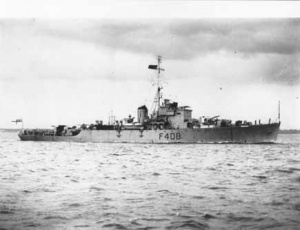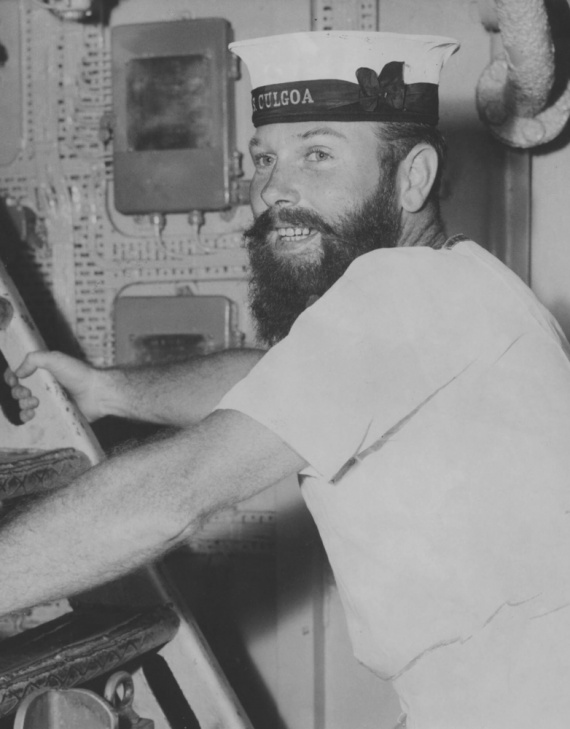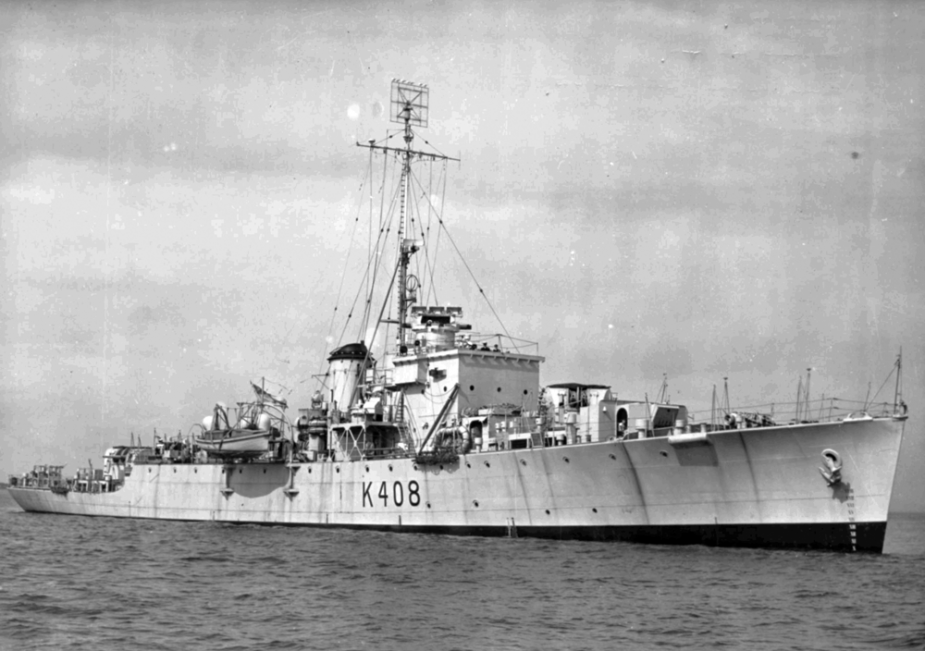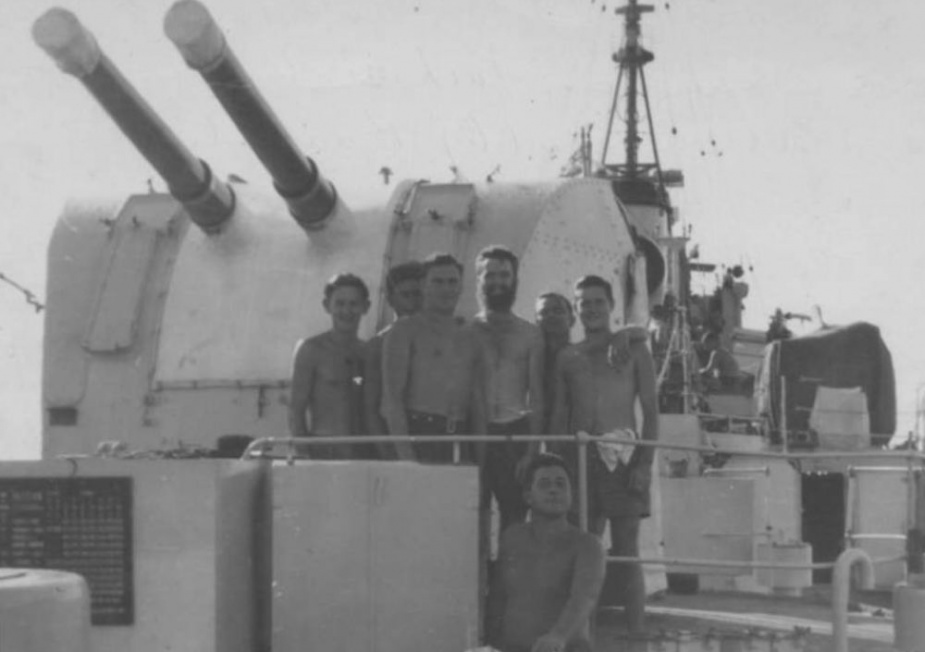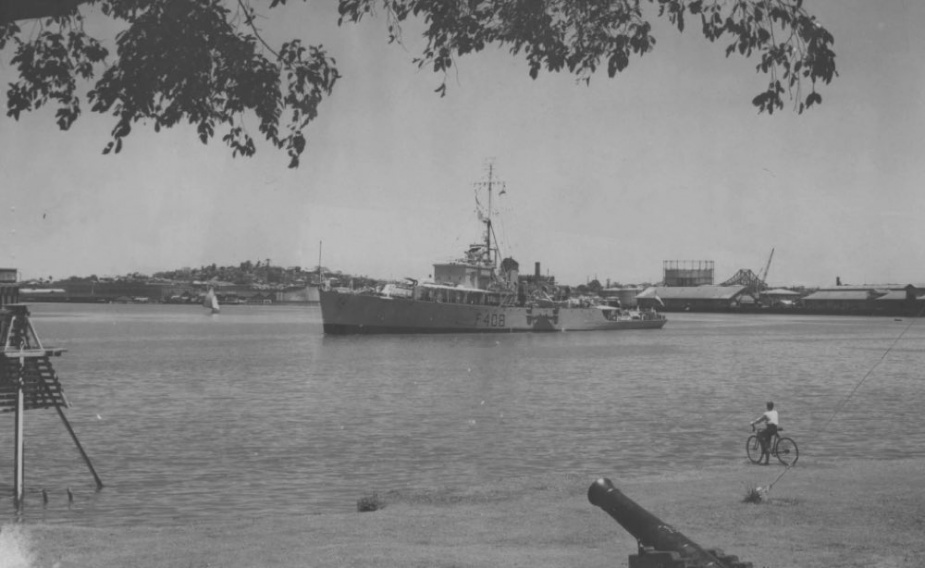HMAS Culgoa
| Class |
River Class |
|---|---|
| Type |
Frigate |
| Pennant |
K408 |
| Builder |
HMA Naval Dockyard, Williamstown, Melbourne |
| Laid Down |
15 July 1943 |
| Launched |
22 September 1945 |
| Launched by |
Mrs Showers, wife of the Second Naval Member |
| Commissioned |
1 April 1947 |
| Decommissioned |
15 April 1954 |
| Dimensions & Displacement | |
| Displacement |
|
| Length | 301 feet |
| Beam | 36 feet |
| Draught | 12 feet |
| Performance | |
| Speed | 19.5 knots |
| Complement | |
| Crew | 175 |
| Propulsion | |
| Machinery | Triple expansion, 2 shafts |
| Horsepower | 5,500 |
| Armament | |
| Guns |
|
| Other Armament |
|
| Awards | |
| Battle Honours | KOREA 1950-53 |
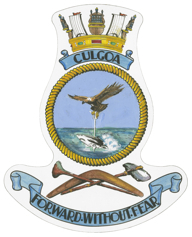
HMAS Culgoa was ordered as part of Australia's shipbuilding program during the Second World War. Twelve of these Australian-built frigates were to enter service with the Royal Australian Navy. A further ten were ordered but cancelled as the war drew to a close.
Eight, HMA Ships Barcoo, Barwon, Burdekin, Diamantina, Gascoyne, Hawksbury, Lachlan and Macquarie, were built to the British River Class design and Australia likewise named its frigates after Australian rivers. A further four, HMA Ships Condamine, Culgoa, Murchison and Shoalhaven, were also named after Australian rivers but were built to the design of the Royal Navy's Bay Class Frigates. These latter ships were generally known as Modified River Class Frigates although they are sometimes referred to as Bay Class.
On completion Culgoa was immediately placed into Reserve, but was commissioned at Melbourne on 1 April 1947 under the command of Lieutenant Commander Herbert L Gunn DSC RAN.
Culgoa departed Sydney on 9 June 1947 for service in Japanese waters, returning to Australia in December 1947. Between April to June 1948 she Culgoa operating around New Guinea and the Solomon and New Hebrides Islands.
In January 1949 Culgoa deployed to the New Guinea area, commencing that month with the transportation of Japanese war criminals from Rabaul to Manus. She returned to Sydney on 3 April 1949 and 10 August 1949 commenced a second deployment to Japan, remaining there until February 1950.
From September to November 1950 Culgoa cruised in the Solomon Islands and Noumea areas and from August 1951 to September 1952 she was used as a training platform for National Service Trainees. In October 1952 she supported the first British atomic test at the Monte Bello Islands.
On 3 March 1953 Culgoa sailed from Sydney for Japan to take up her role in the Korean War. She arrived at Sasebo and reported for duty to the Flag Officer Second-in-Command, Far East Station (Rear Admiral Clifford), on 14 April. She relieved her sister ship HMAS Condamine.
She commenced operations on 19 April 1953 when she arrived off Paengyong Do to relieve HMS Whitesand Bay on the west coast patrol. Culgoa remained on patrol anchored off Paengyong Do by day and under way at night until 28 April, when she was relieved on station by HMNZS Kaniere.
On 21 April she gave strong support to partisan troops in trouble ashore on the mainland. While a United States sergeant spotted, Culgoa fired 102 rounds of 4-inch ammunition, dispersing the attacking North Korean forces, killing many. The enemy's mortars were silenced and the partisan troops were able to evacuate the mainland to the safety of off shore islands. An attempt to repeat this successful shoot on 26 April, when a patrol landed on the mainland to gather wood and draw the enemy, failed when the North Koreans refused to rise to the bait.
On 28 April Culgoa proceeded to the Chodo/Sokto area to operate under the orders of Commander Task Unit 95.1.4 in HMCS Haida on bombardment support until 3 May.
Culgoa began her second patrol on 18 May in the Chodo area, spending the next five days daily bombarding enemy positions on the Amgak Peninsula. 20 May was spent south of Chodo assisting USS Cocopa to locate and salvage a crashed Sea Fury. On 23 May HMS St Brides Bay relieved Culgoa in Task Unit 95.1.4.
On 24 May Culgoa arrived at Taeyongpyong Do and relieved HMS Sparrow in command of Task Unit 95.1.6. The ships attached were six small craft of the South Korean Navy and two minesweepers for operations and three patrol craft for shepherding a fleet of 700 fishing junks. The patrol which ended with departure for Kure on 7 June proved uneventful.
In June Culgoa spent two uneventful weeks on the west coast patrol in the Haeju area, mainly on the routine and unspectacular task of protecting Taeyongpyong Do from invasion.
On 23 June the Australian frigate, after cooperating with aircraft from USS Bairoko in a strike against Chomi Do, fired her last shots of the Korean War with a 37 round bombardment of Communist troops invading the island of Yongmae Do. The patrol ended on 29 June when, after handing over to HMS Charity, the frigate proceeded for Hong Kong. Culgoa returned to the Korean west coast the day of the Armistice, 27 July, relieving HMNZS Hawea at Paengyong Do, assuming the duties of Commander Task Unit 95.1.5 and beginning the first of a series of Armistice patrols.
On 2 November 1953 Culgoa finally detached from the Korean patrol duties to return to Australia. She arrived in Melbourne on 11 December.
Culgoa paid off into Reserve on 15 April 1954, having steamed 167,447 miles. She remained in Reserve until used as an accommodation ship for Sydney minesweeping base, HMAS Waterhen. On 15 February 1972 Culgoa was sold to NW Kennedy Ltd of Vancouver, Canada. In March 1972 she left Sydney under tow for Hong Kong en route to Taiwan for breaking up.

